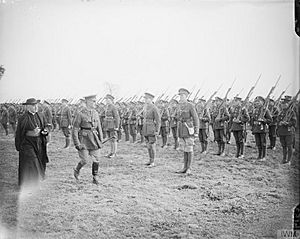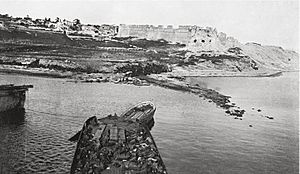Royal Dublin Fusiliers facts for kids
Quick facts for kids The Royal Dublin Fusiliers |
|
|---|---|
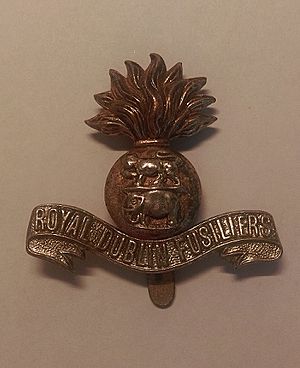
Royal Dublin Fusiliers Cap Badge
|
|
| Active | 1 July 1881 – 31 July 1922 |
| Country | |
| Branch | |
| Type | Line Infantry |
| Garrison/HQ | RHQ: Naas Barracks, Naas, County Kildare |
| Nickname(s) | The Blue Caps, The Dubs, The Lambs, The Old Toughs |
| March | Quick: The British Grenadiers Unofficial: The Dublin Fusiliers |
| Commanders | |
| Ceremonial chief | Prince Arthur, Duke of Connaught and Strathearn (1908) |
| Colonel of the Regiment |
Major-General Charles Duncan Cooper (1910) |
| Insignia | |
| Hackle | Blue over Green |
The Royal Dublin Fusiliers was a famous infantry regiment in the British Army. It was formed in 1881 and stopped existing in 1922. This regiment was one of eight "Irish" regiments in the army. These units were set up and based in Ireland. The Royal Dublin Fusiliers had its main base in Naas.
The regiment was created by joining two older army regiments: the Royal Bombay Fusiliers and the Royal Madras Fusiliers. These two regiments were based in India. Also, local army groups from Dublin and Kildare joined them. This was part of big army changes called the Childers Reforms. Both parts of the regiment fought in the Second Boer War.
During World War I, the regiment grew to include six more groups. They fought in major battles on the Western Front in Europe, in the Mediterranean Sea, and in the Middle East. Three of its members won the Victoria Cross, which is the highest award for bravery. After the Irish Free State was formed in 1922, five army regiments that recruited mainly from this new state, including the Royal Dublin Fusiliers, were disbanded.
Contents
History of the Royal Dublin Fusiliers
How the Regiment Started
The Royal Dublin Fusiliers began on 1 July 1881. It was formed by combining the 102nd Regiment of Foot (Royal Madras Fusiliers) and the 103rd Regiment of Foot (Royal Bombay Fusiliers). These two older regiments had started as European groups within the East India Company. In 1861, when the British Crown took over the company's army, these regiments became part of the British Army.
As part of the army changes, five infantry groups were given Irish names. The 102nd and 103rd Regiments became the 1st and 2nd Battalions of The Royal Dublin Fusiliers. This regiment was one of eight Irish regiments. They mostly recruited soldiers from Ireland, especially from Dublin, Kildare, Wicklow, and Carlow. Their main base was in Naas.
The 1st Battalion was in Ceylon (now Sri Lanka) when it became part of the new regiment. It moved back to the UK in 1886, staying in England before going to the Curragh in Ireland. In 1893, it returned to England. It stayed there until the Second Boer War started in South Africa in 1899. The battalion arrived in South Africa in November 1899.
The 2nd Battalion was in England when it was formed. In 1884, it moved to Gibraltar. The next year, it went to Egypt, and then to India in 1889. It was based in different places there. In 1897, the 2nd Dublins were in Natal Colony. They were still there when the Boer War began in 1899.
Fighting in the Second Boer War
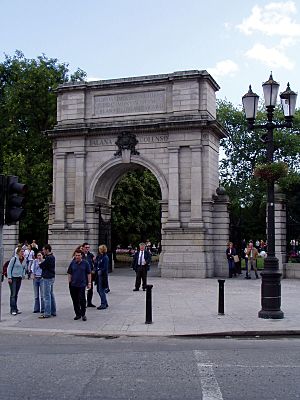
The Boers started the war on 12 October 1899. They invaded Natal and the Cape Colony. On 20 October, the 2nd Dublins fought in the first big battle of the war. This was the Battle of Talana Hill near Dundee. The Boers were on Talana Hill. The British soldiers attacked the hill and, after tough fighting, pushed the Boers away. The Dublins had many soldiers killed or wounded. Captain George Anderson Weldon was the first officer from the Dublins to die in the war. The British had to leave Dundee soon after and moved to Ladysmith. The Boers then surrounded Ladysmith in late October.
On 15 November 1899, some Dubliners and other soldiers were on an armoured train. This train was checking on Boer movements. The Boers attacked them, and part of the train went off the tracks. Winston Churchill, who was a war reporter, was on the train. He helped load wounded soldiers onto the engine, which then escaped. The remaining soldiers fought bravely but had to surrender. Churchill, who had returned to help, was captured but later escaped. He praised the courage of the Dublin Fusiliers. The Dublins lost three men in this ambush.
The Dublin Fusiliers worked hard to end the Siege of Ladysmith. This siege lasted from 30 October 1899 to 28 February 1900. On 15 December, the 2nd Dublins fought in the Battle of Colenso. They were part of the "Irish Brigade." They crossed the wrong part of the Tugela River and suffered many casualties. This battle was a defeat for the British. It was part of a difficult time for the British called "Black Week."
The Dublins continued to fight in January 1900 in the Battle of the Tugela Heights. In February, they fought hard. On 27 February, they helped the Royal Irish Fusiliers charge Pieters Hill. They took the position but had many losses. This victory led to the siege of Ladysmith being lifted the next day. On 10 March 1900, Queen Victoria said that Irish units should wear a shamrock on their hats on Saint Patrick's Day. This was to remember their bravery in South Africa. This tradition continues today.
In May, the British moved towards the Transvaal. The Dublins helped attack Laing's Nek to enter the Transvaal. They succeeded, and the capital, Pretoria, was captured on 5 June. But the war did not end. The Boers started a guerrilla campaign. Many blockhouses were built to stop the Boers, and Dublin Fusiliers helped guard them. The Dublins also hunted for Christiaan de Wet, a famous Boer officer.
The war ended in May 1902 when the last Boers surrendered. The Treaty of Vereeniging officially ended the fighting. The Dublins had nearly 700 soldiers killed, wounded, or missing. Many died from disease, which was common in the British Army.
After the war, the 1st Battalion moved to Malta in November 1902. It was also partly based in Crete. In 1906, it went to Egypt. There, it received its flags, called Colours, from Prince Arthur, Duke of Connaught and Strathearn, who was the regiment's leader. The 1st Dublins then joined the British army in India until World War I began in 1914.
The 2nd Battalion returned to the UK after the war. It was based in Buttevant, Cork, Ireland. In 1910, it moved to Aldershot, England. It received its new Colours there the next year. It stayed in England until the war started in 1914.
The First World War (1914-1918)
World War I started in August 1914. The British Empire declared war on Germany. The Royal Dublin Fusiliers created 6 new battalions during the war, making 11 in total. They fought on the Western Front, in Gallipoli, the Middle East, and Salonika. The regiment earned 3 Victoria Crosses for bravery. They also received 48 Battle Honours and 5 Theatre Honours. The regiment lost over 4,777 soldiers during the war.
Fighting on the Western Front
The 2nd Dublins arrived in France in August 1914. They were part of the British Expeditionary Force (BEF), which was made up of professional soldiers. The 2nd Dublins took part in the retreat after the Battle of Mons. On 26 August 1914, they fought at Le Cateau. This battle helped slow down the German advance towards Paris. The Dublins caused many German casualties. Many Dublin Fusiliers were trapped behind German lines and became prisoners. The battalion, with fewer soldiers, then fought in the Battle of the Marne (5–9 September). This battle finally stopped the German advance near Paris. The Germans had to retreat. The 2nd Dublins then fought in the Battle of the Aisne. Their last major battle of 1914 was the Battle of Messines, which started on 12 October.
The 2nd Dublins fought in almost all the battles during Second Ypres (22 April – 24 May 1915). The battalion suffered huge losses at the Battle of St Julien. They then fought in the battles of Frezenberg and Bellewaarde. On 24 May, the Germans attacked the battalion with poison gas near Saint-Julien. The battalion was almost completely destroyed. At that time, the British had no protection against gas attacks. The 2nd Dublins' commanding officer, Lieutenant Colonel Arthur Loveband, died the next day.
The 8th and 9th Dublins arrived in France in December 1915. They were also attacked with German gas at the Battle of Hulluch on 27 April 1916. They suffered many casualties. The British started the Somme offensive on 1 July. The 1st and 2nd Dublins fought on the First day on the Somme. British forces had huge losses, with about 60,000 casualties. The 8th and 9th Dublins fought in their first major battle during the Somme offensive. They helped capture Ginchy on 9 September. Lieutenant Tom Kettle was killed in action there. The Dublins also fought in the last big battle of the offensive, at the Ancre (13–18 November). The Dublins again had many casualties during the Somme offensive.
In March 1917, the Germans moved back to the Hindenburg Line, which was a very strong defence. In April, the British started the Arras Offensive. The Dublin Fusiliers fought in two battles of the Scarpe in April. The 10th Dublins fought in the Battle of Arleux (28–29 April). In June, the Dublins helped capture Wytschaete during the Battle of Messines. The regiment's battalions then fought in the Third Battle of Ypres (31 July – 10 November). They were in several smaller battles, including Langemarck. The regiment suffered greatly. The 9th Dublins had so many losses that they joined with the 8th Dublins in October, forming the 8th/9th Dublins. The regiment's last major action of 1917 was an attack during the Battle of Cambrai (28 November – 3 December).
In February 1918, because of heavy losses, the 8th/9th and 10th Dublins were disbanded. Their soldiers moved to the 1st and 2nd Dublins. On 21 March, the regiment was defending during the Battle of St. Quentin. The Germans launched a huge attack with bombs and poison gas. The 1st and 2nd Dublins suffered greatly. The Germans broke through the weakened lines. The Germans gained a lot of ground, but their attack slowed down. They were pushed back by April. In April, the 1st and 2nd Dublins had to combine for a short time because of their losses, forming the 1st/2nd Dublins. The 1st Battalion was reformed a few days later. In August, the Allies started their counter-attack against the Germans. They reached the Hindenburg Line. In September, the 1st, 2nd, and 7th Dublins fought in battles like the St Quentin Canal, Cambrai, and Beaurevoir. The Hindenburg Line was broken. The Dublins fought in the last attacks of the war, including the Fourth Battle of Ypres and the Battle of Courtrai. The 1st Dublins lost their commanding officer on 14 October. The regiment's last major battle was the Battle of the Sambre on 4 November. The war on the Western Front ended with the Armistice on 11 November 1918.
Gallipoli, Salonika, and the Middle East
The 1st, 6th, and 7th Dublins fought in the Allied Gallipoli Campaign in the Dardanelles. This was after Turkey joined Germany's side in November 1914. The goal was to help Russia by keeping the Dardanelles Strait open. The 1st Dublins landed at V Beach, Cape Helles on 25 April. They were the first to land and suffered many casualties from Turkish machine-gun fire. Many soldiers died before even leaving their boats. Other soldiers drowned because of their heavy equipment. Despite heavy losses, the British landed many troops by nightfall. On 26 April, the British, including the Dublins, took the fortress. They then moved to the village of Sedd el Bahr. The 1st Battalion had over 600 casualties in the first two days. Almost all their officers were killed. The battalion had so many losses that it had to combine with another group, called the 'Dubsters', for a short time.
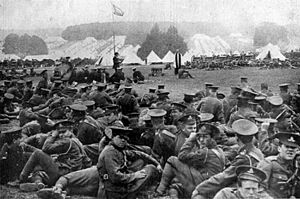
The 6th and 7th Dublins were formed in August 1914. They left Ireland for Basingstoke, England, in May 1915. On 7 June, they left the UK for Lemnos to prepare for landings at Suvla Bay, Gallipoli. The Dublins landed at Suvla on 7 August. Suvla was not well defended, but mistakes by commanders meant the British did not use their early advantage. This allowed the Turks to strengthen their defences. The Dublins helped capture Chocolate Hill (7–8 August), which they took but at a high cost. On 9 August, the Dublins tried to recapture Scimitar Hill. They gained some ground but faced strong Turkish resistance and had to retreat. In September, the 6th and 7th Dublins left Suvla for Mudros on Lemnos.
On 1 January 1916, the 1st Dublins left Gallipoli for Egypt. The last British troops left Gallipoli on 9 January. The evacuation was actually the most successful part of the campaign. The Dublins had suffered greatly. Almost all of the 1,000 men of the 1st Dublins who landed at Helles in April were killed, wounded, sick, or missing.
Meanwhile, the 6th and 7th Dublins landed in Salonika in October 1915. They were part of a British-French force helping Serbia against Bulgaria. By the time they arrived, Serbia had been defeated. The Dublins fought in the Battle of Kosturino (7–8 December) and in the British retreat from Serbia. After Kosturino, things were mostly quiet, but soldiers still suffered from diseases like dysentery and malaria, and also from frostbite. In October 1916, the Dublins helped capture the village of Yenikoi. They had many casualties, including from their own artillery. In August 1917, the 6th and 7th Dublins moved to Egypt. They then joined the Palestine campaign. This campaign was more successful. The Dublins fought in the Third Battle of Gaza (27 October – 7 November). They also helped capture Jerusalem and defend it from Turkish attacks. The 7th Dublins left the division in April 1918 and moved to France. The 6th Dublins followed in July.
The 1916 Easter Rising
Three battalions of the Royal Dublin Fusiliers fought against rebels during the Easter Rising in Dublin in 1916. Eleven Royal Dublin Fusiliers soldiers were killed, and 35 were wounded. John Dillon, an Irish Member of Parliament, said that the Dublin Fusiliers fought bravely, even though they were fighting against people from their own country.
Disbandment of the Regiment
All the battalions created during the war were disbanded either during or shortly after the war. The 1st Dublins entered Germany in early December. They reached Cologne, where the British Army was based. The battalion returned to the UK soon after. The 2nd Dublins left Europe for Constantinople, Turkey. In late 1920, they moved to Multan, India, before returning to the UK in 1922.
Because of big cuts in defence spending and the creation of the Irish Free State in 1922, it was decided that six regiments from Southern Ireland would be disbanded. This included the Royal Dublin Fusiliers. On 12 June, five regimental flags (Colours) were placed in a special ceremony at St George's Hall, Windsor Castle. King George V was there. The Dublin Fusiliers group included the commanding officers of the 1st and 2nd Dublins. The six regiments were all disbanded on 31 July 1922.
After the Irish Civil War began, thousands of former soldiers and officers from these regiments joined the new National Army of the Free State. These British Army veterans had a lot of combat experience. By May 1923, they made up 50% of the 53,000 soldiers and 20% of the officers in the National Army.
On 27 April 2001, the Irish government officially recognized the soldiers of the Royal Dublin Fusiliers who fought in World War I. They held a special event at Dublin Castle for the Royal Dublin Fusiliers Association.
Battalions of the Regiment
Here are the different groups (battalions) of the regiment during its time:
Original Battalions
- 1st Battalion (Regular), stopped existing in 1922. It was the former 102nd (Royal Madras Fusiliers) Regiment of Foot.
- 2nd Battalion (Regular), stopped existing in 1922. It was the former 103rd (Royal Bombay Fusiliers) Regiment of Foot.
- 3rd (Kildare Rifles Militia) Battalion (Special Reserve), stopped existing in 1922.
- 4th (Queen's Own Royal Dublin City Militia) Battalion (Extra Reserve), stopped existing in 1922.
- 5th (Dublin County Light Infantry Militia) Battalion (Extra Reserve), stopped existing in 1922.
Battalions during World War I
- 6th (Service) Battalion, formed in 1914, disbanded in 1919.
- 7th (Service) Battalion, formed in 1914, joined 2nd Battalion in 1918.
- 8th (Service) Battalion, formed in 1914, combined with another and disbanded in 1918.
- 9th (Service) Battalion, formed in 1914, combined in 1918.
- 10th (Service) Battalion, formed in 1915, disbanded in 1918.
- 11th (Reserve) Battalion, formed in 1916, disbanded in 1918.
Victoria Cross Heroes
The Victoria Cross is the highest award for bravery in the British military. These soldiers from the Royal Dublin Fusiliers received it:
- Sergeant Horace Augustus Curtis (2nd Battalion) - World War I, 13 October 1918
- Sergeant Robert Downie (2nd Battalion) - World War I, 23 October 1916
- Sergeant James Ockendon (1st Battalion) - World War I, 4 October 1917
Battle Honours
The regiment earned many battle honours, which are awards for fighting in important battles. Some of these include:
- From older regiments: Arcot, Plassey, Pondicherry, Lucknow, Kirkee, Aden.
- Siege of Ladysmith, South Africa 1899–1902
- World War I: Le Cateau, Marne 1914, Ypres 1915, Somme 1916, Arras 1917, Messines 1917, Cambrai 1917, Hindenburg Line, France and Flanders 1914–18, Helles, Gallipoli 1915–16, Gaza, Jerusalem, Palestine 1917–18, Macedonia 1915–17.
Memorials to the Great War
These places remember the Royal Dublin Fusiliers who fought in World War I:
- Irish National War Memorial Gardens, Dublin.
- Peace Park, Dublin.
- Island of Ireland Peace Park, Messines, Belgium.
- Menin Gate Memorial Ypres, Belgium.
See also
- British Army Fusilier
- 102nd Regiment of Foot (Royal Madras Fusiliers)
- 103rd Regiment of Foot (Royal Bombay Fusiliers)
Sources
- J.B.M. Frederick, Lineage Book of British Land Forces 1660-1978, Volume I, 1984: Microform Academic Publishers, Wakefield, United Kingdom. ISBN: 1-85117-007-3.



